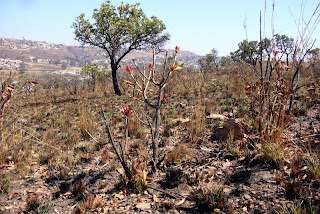Ron and I traveled to Kampala, Uganda, on a training assignment August 6-10, 2010. In a meeting conducted by the stake president we met with 26 leaders in Kampala Stake regarding building security and stewardship responsibility. On personal security topics specific to their mission, we met with the mission president and his staff. Our schedule also included an interview with the security officer at the U.S. Embassy, interviews with four missionaries, and surveys of five meetinghouses and three missionary residences.
Referred to as the Pearl of Africa, Kampala is built amidst rolling hills covered with tropical foliage and exotic flowers at 4000' elevation. Sitting 20 miles north of the equator it has just two seasons, dry and rainy. Pleasant daytime temperatures during our dry season ranged from morning 60s to afternoon 80s.

Open air merchant shops line the streets and roadways from early morning to night time hours. Driving 45 minutes from the Entebbe airport, which sits virtually on the shores of Lake Victoria, into downtown Kampala we were awed by shops and people all along our route. The wide array of businesses still open after 7 p.m. on a darkening Friday night included hair salons and barber shops; fruit and vegetable stands; shoe, dress and clothes shops; pharmacies; bakeries, milk stores and butcher shops with hanging meats; hardware, electronics and auto parts shops; TV stores and cell phone stalls to buy minutes and recharge batteries. Interspersed among the shops were numerous churches and gas stations. With no street lights, each shop was illuminated by a single curly energy saving light bulb or florescent tube light.
Fresh vegetables and fruits like avacado, pineapple, papaya, mangos and gonja (sweet bananas) and were abundantly available. Along with rice a staple food is Matooke, green cooking bananas baked in banana leaves and served mashed with peanut sauce.
Resourceful and beautifully dressed women carry babies tied on their backs, baskets and sacks filled with goods on their heads. Collecting water in plastic containers is a daily task for most citizens.


















